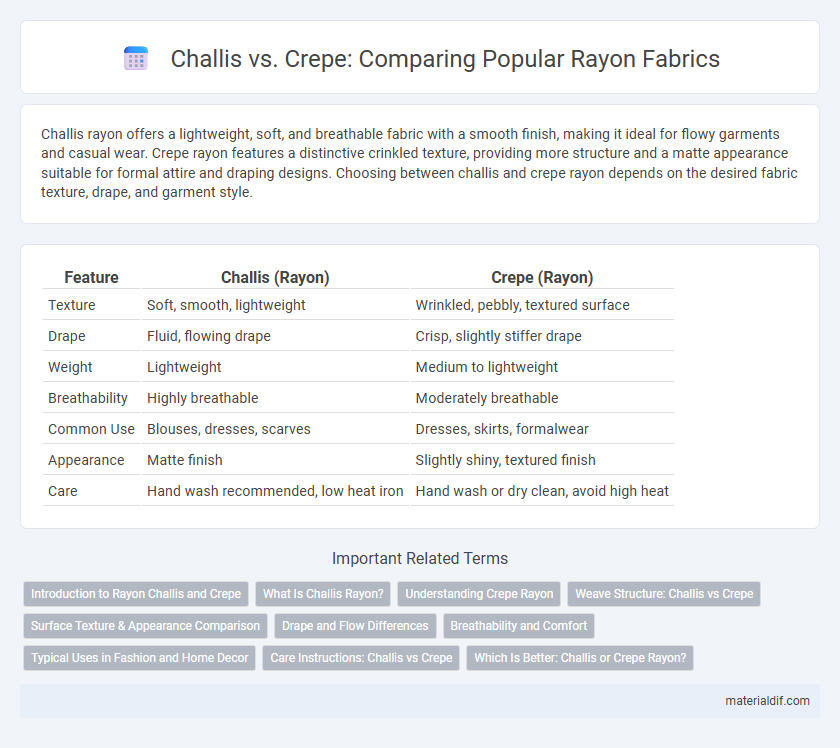Challis rayon offers a lightweight, soft, and breathable fabric with a smooth finish, making it ideal for flowy garments and casual wear. Crepe rayon features a distinctive crinkled texture, providing more structure and a matte appearance suitable for formal attire and draping designs. Choosing between challis and crepe rayon depends on the desired fabric texture, drape, and garment style.
Table of Comparison
| Feature | Challis (Rayon) | Crepe (Rayon) |
|---|---|---|
| Texture | Soft, smooth, lightweight | Wrinkled, pebbly, textured surface |
| Drape | Fluid, flowing drape | Crisp, slightly stiffer drape |
| Weight | Lightweight | Medium to lightweight |
| Breathability | Highly breathable | Moderately breathable |
| Common Use | Blouses, dresses, scarves | Dresses, skirts, formalwear |
| Appearance | Matte finish | Slightly shiny, textured finish |
| Care | Hand wash recommended, low heat iron | Hand wash or dry clean, avoid high heat |
Introduction to Rayon Challis and Crepe
Rayon Challis is a lightweight, soft fabric known for its smooth texture and excellent drape, commonly used in dresses, blouses, and scarves. Rayon Crepe features a slightly crinkled, textured surface with a matte finish, providing a more structured appearance while retaining softness and breathability. Both fabrics are made from regenerated cellulose fibers, offering versatility and comfort but differing mainly in their texture and garment application.
What Is Challis Rayon?
Challis rayon is a lightweight, soft, and breathable fabric known for its smooth texture and excellent drape, making it ideal for flowing garments like dresses and blouses. It features a slightly matte finish and a finer weave compared to crepe, providing enhanced comfort and subtle elegance. Challis rayon's versatility and softness differentiate it from the slightly crisper, textured surface of crepe rayon.
Understanding Crepe Rayon
Crepe rayon is distinguished by its crinkled or pebbled texture, achieved through specialized yarn twisting and fabric construction, resulting in a soft, drapey material that resists wrinkles better than challis rayon. Unlike challis, which is smooth and lightweight with a matte finish, crepe rayon offers enhanced texture and visual interest, making it ideal for garments requiring subtle structure and fluidity. Its breathable, moisture-wicking properties combined with a slightly heavier weight than challis ensure comfort and durability in various apparel applications.
Weave Structure: Challis vs Crepe
Challis fabric features a plain weave structure that produces a soft, lightweight, and breathable texture ideal for flowing garments. In contrast, Crepe rayon utilizes a highly twisted yarn in a plain or satin weave, resulting in a distinctive crinkled surface and enhanced elasticity. The weave structure difference directly impacts the drape and tactile experience, with Challis offering smoothness and Crepe providing a textured, slightly puckered finish.
Surface Texture & Appearance Comparison
Challis rayon features a smooth, soft texture with a matte finish that drapes fluidly, making it ideal for lightweight garments requiring a delicate look. Crepe rayon exhibits a distinctive crinkled or pebbled surface texture, providing a textured appearance with subtle shine and enhanced visual depth. The primary difference in surface texture between challis and crepe rayon lies in challis's smooth, flat weave versus crepe's irregular, puckered weave, influencing both appearance and tactile experience.
Drape and Flow Differences
Challis rayon fabric exhibits a lightweight, smooth texture, providing a soft drape that flows gently over contours, making it ideal for casual dresses and blouses. Crepe rayon features a textured surface with a slightly crinkled appearance, delivering a more structured drape and moderate flow, suitable for garments requiring subtle body and elegance. The primary distinction lies in challis's fluid, airy drape versus crepe's textured, controlled movement, influencing garment silhouette and comfort.
Breathability and Comfort
Challis rayon fabric offers superior breathability due to its lightweight, finely woven texture, making it ideal for warm climates and casual wear. Crepe rayon features a crinkled, textured surface that provides a slightly heavier feel but retains moisture-wicking properties for comfort. Both fabrics provide softness and drape, yet challis excels in air circulation, enhancing overall comfort during prolonged use.
Typical Uses in Fashion and Home Decor
Challis rayon fabric is lightweight, soft, and breathable, making it ideal for flowy dresses, blouses, and scarves in fashion as well as curtains and bed linens in home decor. Crepe rayon, characterized by its crinkled texture and slightly heavier weight, is preferred for tailored garments like suits, dresses, and skirts, lending a sophisticated drape that also suits cushion covers and drapery. Both fabrics offer versatility, with challis excelling in casual, breathable applications and crepe favored for structured, elegant designs.
Care Instructions: Challis vs Crepe
Challis rayon requires gentle hand washing or machine washing on a delicate cycle with cold water to maintain its softness, while crepe rayon demands dry cleaning or careful hand washing to preserve its textured surface. Both fabrics should be air-dried flat or hung to prevent shrinking and distortion, avoiding direct sunlight to retain color vibrancy. Ironing challis rayon is best done with low heat using a pressing cloth, whereas crepe rayon needs a cooler iron setting to protect its crinkled finish.
Which Is Better: Challis or Crepe Rayon?
Challis rayon offers a lightweight, breathable texture ideal for flowing garments and casual wear, while crepe rayon is distinguished by its slightly crinkled surface that provides more structure and elegance, making it suitable for formal attire. Challis is better for comfort and drape in everyday clothing, whereas crepe rayon excels in durability and maintaining shape in tailored pieces. Choosing between challis and crepe rayon depends on whether softness and fluidity or texture and formality are prioritized in the fabric's end use.
Challis vs Crepe (rayon fabrics) Infographic

 materialdif.com
materialdif.com